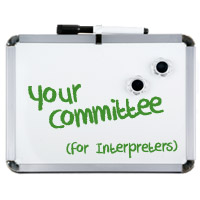Interpreter Tips Articles
Signs That Are Close... But Not the Same - Iconic Signs
This article is part of our “Signs That Are Close... But Not the Same” series, which highlights signs that look similar, but have different meanings. The signs discussed in this article include (1) Type vs. Piano, (2) Pencil vs. Write, (3) Ice Cream vs. Microphone, (4) Telephone vs. Cell Phone, (5) Telephone vs. Call, and (6) Tree vs. Deaf Applause.
Signs That Are Close... But Not the Same - Set 13
This article is part of our “Signs That Are Close... But Not the Same” series, which highlights signs that look similar, but have different meanings. The signs discussed in this article include (1) Decide vs. Court, (2) Supervise vs. Take Care Of, (3) Shoes vs. Advertise, (4) Awkward vs. Walk Fast, and (5) Race vs. Game.
Interpreter Q & A: If the Deaf client isn’t paying attention, should the interpreter keep signing?
This Interpreter Q & A ask: If the Deaf client isn’t paying attention, should the interpreter keep signing as normal? This article is part of our "Dear BC, Interpreter Q & A” series, which answers questions on interpreting and Deaf culture from multiple perspectives.
Signs That Are Close... But Not the Same - Set 12
This article is part of our “Signs That Are Close... But Not the Same” series, which highlights signs that look similar, but have different meanings. The signs discussed in this article include (1) THILLED vs. EXCITED, (2) PRINT vs. NEWSPAPER, (3) SOLD vs. SELLING, (4) SIGNATURE vs. CONTRACT, and (5) GOVERNMENT vs. FEDERAL.
Interpreter 4-1-1: Your Reputation
As a professional interpreter, it is wise to consider your reputation in the community in which you work. Your reputation is formed on a number of important factors. Are you prepared? Are you dressed appropriately? Are you ready to represent the client and profession to the best of your ability? Are you engaged and give back to the community?
Signs That Are Close... But Not the Same - Set 11
This article is part of our “Signs That Are Close... But Not the Same” series, which highlights signs that look similar, but have different meanings. The signs discussed in this article include (1) SEVERAL vs. FEW, (2) USE vs. GET USED TO, (3) LONG AGO vs. USED TO, (4) INTRODUCE vs. INVITE, and (5) PROBLEM vs. DIFFICULT.
Interpreter 4-1-1: Your Interpreter Committee
All of us have heard “little voices” in our head. There may be a voice when you do something you shouldn’t, when you receive praise or when you’re trying to stay motivated. It could be the voice of a parent, a coach, a teacher, a friend, or anyone.
This chorus of voices is sometimes referred to as “The Committee” by interpreters. It represents our minds talking to us while we’re working, playing and living life. Think about what you hear when you’re interpreting. Is your Committee nice? Are they supportive? Do any Committee members have a louder voice than the rest? Here are examples of possible Committee members...
Signs That Are Close... But Not the Same - Set 10
This article is part of our “Signs That Are Close... But Not the Same” series, which highlights signs that look similar, but have different meanings. The signs discussed in this article include (1) CAFETERIA vs. TWIN vs. RESTAURANT, (2) SOCKS vs. STARS, (3) SEE vs. WATCH, and (4) ENOUGH vs. FULL.
Interpreter Q & A: Using Your Phone During a Break
This Interpreter Q & A asks: During a lull in a staff meeting where I was interpreting, I used my phone to enter some appointments into my calendar (and check my grocery list). Afterwards, my team interpreter told me that she thought doing that was rude and unprofessional. Do you agree?
This article is part of our "Dear BC, Interpreter Q & A” series, which answers questions on interpreting and Deaf culture from multiple perspectives.
Interpreter Q & A: What are our boundaries as interpreters to say something to a Deaf client about their right to request a qualified interpreter?
This Interpreter Q & A asks: During a doctor’s appointment I interpreted, the doctor referred the Deaf patient to physical therapy. When we were leaving the office, the Deaf client asked me about my availability to interpret her upcoming physical therapy appointments. I told the Deaf woman my schedule and she said, “Oh well, that’s fine, if you can’t come, my daughter will come and interpret.” Her daughter is a young girl who can sign, but she is not an interpreter. The daughter has no training or certification.
What are our boundaries as interpreters to say something to a Deaf client about their right to request a qualified interpreter? I don’t want to look like I’m just trying to make money. My concern is also that her doctors will begin to think that they don’t need to hire interpreters for her because she can just bring her daughter for free.
This article is part of our "Dear BC, Interpreter Q & A” series, which answers questions on interpreting and Deaf culture from multiple perspectives. This article was also published in the Fall 2018 (Issue 35 Volume 4) Edition of VIEWS Magazine from RID.
ADVERTISEMENTS

















